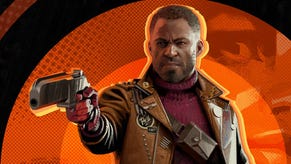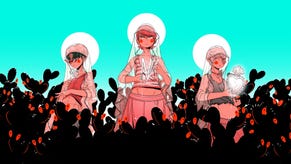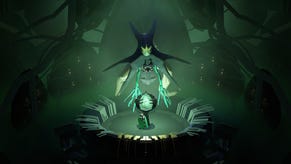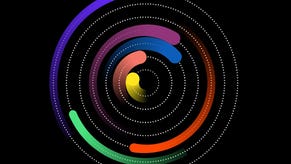The unexpected dread of Cocoon: how the bug became a feature
Scope creep.
It took Geometric Interactive a while to find the insect in Cocoon, though it's perhaps more accurate to say that the insect found Cocoon, pupating of its own accord from the texture of this delightful but oh so eerie top-down puzzle-platformer. "When I joined the studio, the demo was just like, 2D pixels with blocks," says Erwin Kho, art director. "The little character that you're moving around was a white box with sort of a brown basket on their back. And I think we all gravitated towards sci-fi, so I just immediately started doing things with astronauts or robots.
"And at some point, I had this little astronaut character that I thought was a bit disappointing, because, you know - it's just a person with a helmet and a golden visor. So I gave him a little cape, because capes are cool. But a lot of videogame characters have a cape, so I thought, maybe I'll just split it in two or something. And with the cape split in two, it suddenly looks like wings."
"Your choice with the character eventually sparked the idea for what this entire thing is about, kind of?" interjects game director and designer Jeppe Carlson, otherwise known as the lead gameplay designer for PlayDead's Limbo - a game which, it only now occurs to me, starts in a forest prowled by an enormous spider. "That's not something we knew from the get-go. It's an exploratory process for us to figure out the story of this game? I think that put us on a good track." Kho pushes back on this claim modestly. "It started with the gameplay that Jeppe came up with. All the lore that we sort of had for ourselves, it just developed over time."
Not quite knowing where things began, and from what - that's business as usual for any kind of art-making, I guess, but the idea is especially resonant here, because Cocoon is a game about not quite knowing where the world begins or ends. You begin the game in a baking desert landscape of flat oranges and delicious, tall shadows. Light drips from the sky and splits the side of a fleshy sphere, from which spills your doughty beetle protagonist.
You scuttle around a bit, discover a weird porous bulge in the earth, and are whirled outward through the screen into an entirely different reality, made up of green and grey metal, diagonal bridges on swivels and lowering pipework. The desert has become a sunbaked marble you can pick up, mount on stands and use as a power source for things like floating platforms. Each area in the game appears to exist inside its own coloured glass orb. You can place these marbles on reflective puddles in order to fly back into the worlds they contain, and many of Cocoon's puzzles hinge on moving between these dimensions - or even more confusingly, transporting worlds inside other worlds to use as puzzle props.
The choice of a playable insect made sense for these conundrums - more sense than an astronaut with a basket, anyway - because if anything can lug an entire universe around on its back, it's surely a bug. "Ants are tiny, but they can carry things many times their own weight and size," Kho notes. "You can see these tiny ants carrying these massive leaves - I had that in my mind. And also dung beetles, you know, it has this massive ball it's rolling around. So those kinds of little influences from the insect world just started creeping into all the designs that we ended up with and discussed."
Creeping. It's definitely the right word for Cocoon. The choice of main character also crept into the game's world-building, transforming what was originally a Brutalist industrial setting into something squishy, fecund and half-aware. "Slowly, biomechanical components came in," Kho goes on. "Like OK, at some point we're going to have things moving around, and I didn't want cogwheels or anything like that - I thought it shouldn't go in that steampunk direction.
"What is the more organic version of machinery and things that can move? It's tendons that can stretch, and hinged arms, you know, like a praying mantis, or lobsters which have complicated limbs. So I started thinking more in those terms - what if the culture in the game had never discovered the cogwheel or whatever, how would they move things around? And so you end up with lots of limbs and stretchy parts."
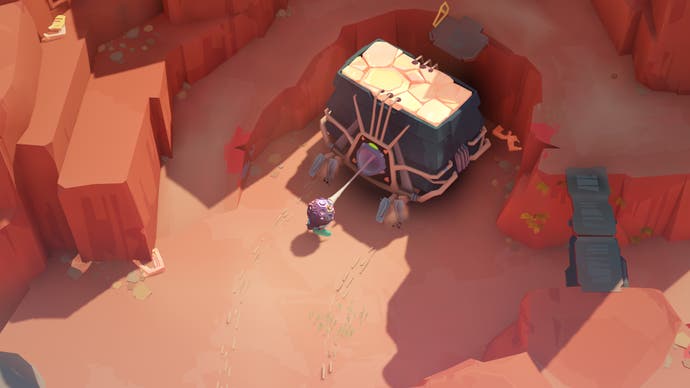

Once Cocoon's world became insectile, it opened itself up to new breeds of puzzle. Carlson cites a "pivotal" moment later in development when he decided to introduce a set of tethered "utility" orbs that can be yanked around like rubbery antennae to operate larger mechanisms. "So now can pull heavy things, like pull this container on train tracks, or something like that - a satisfying interaction. And then Erwin ended up putting insect legs on the container, so that when you grab the orb to pull, it suddenly springs to life.
"You're this little insect pulling this insect machine - I think that was a big moment for me in development, a scene I really love because there's many things just coming together there. It sort of made this game special in my head. And it was also the first of these interactions, that formed all sorts of ideas - we can hold on to objects and make these little 'joysticks', expand on the interactions."
It's probably worth stating at this point that Cocoon is not an outright horror game, like Carlson's previous projects at Playdead. The colour choices wouldn't look out of place in a Wholesome Games showcase, and the section I played during my hands-on has the same marvellously practised and unobtrusive flow as the best Nintendo puzzlers, whereby elaborate tasks somehow resolve themselves without effort when you identify the first step. Taps talked about "nudging" in his Summer Game Fest preview, and yeah, "nudging" absolutely describes how I passed through and between the worlds of Cocoon, not so much figuring things out as prodding gently in different directions till the obstacles gave way.
But there's a dreadfulness to Cocoon that materialises gradually, like the title fonts in Alien. It starts with those icky biomechanical props: I was faintly aghast to discover that one of the curious objects I had to tug around had mollusc feet, burbling as it undulated along the floor. Kho says that this kind of pervasive unsightliness comes naturally to him as an artist. "I generally don't make things too cute. I have to make a lot of effort to make things, like, Hello Kitty cute. So, yeah, that atmosphere is something that I just like gravitate towards."
The premise of warping between cocooned dimensions has even queasier implications. It's a disconcerting inversion of the classic direction of travel for a third-person game, a flipping-around of the vanishing point which leaves the majority of Cocoon's universe unseen. "Most games, they progress forward or inwards," notes Carlson. "But I think this outwards [movement] is a little special, and maybe also a little bit eerie. What else is out there?"

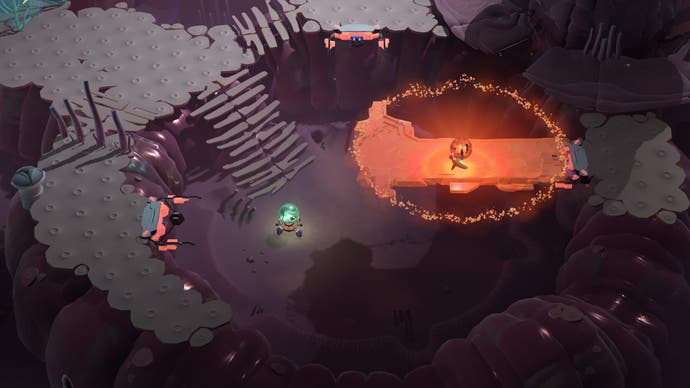
It's easy to imagine how the act of warping outward could be an opportunity to catch the player off-guard, though I don't get the impression that jumpscares in the Resident Evil vein are on the menu. "A lot of the imagery in the beginning is inspired by the Bryce Canyon or Grand Canyon, stuff like that, which for me is exotic," says Kho. "Because you know, we don't have that kind of thing in my part of the world, but it's still relatable and sort of Earth-like. And then the first time you warp out, suddenly you're surrounded by something much more artificial, lots of industry and technology that is fused with the landscape. And there's this weird contrast that happens there which amplifies that sense of oddness."
Insects are well-adapted to navigate such weird contrasts because they're creatures of contrast themselves, he suggests. "There's something a bit alien about insects, I guess, because they're so different from us, but then we can anthropomorphise them, when we look at insects or like insect colonies, or whatnot. So I think there's an interesting tension conceptually." To put that point about anthropomorphisation in terms of the game itself, the beetle in Cocoon is still a human astronaut, on some level. Your movement between scales, each tiny from the perspective of the other, is sort of an exercise in putting that astronaut/beetle distinction under stress.
I personally view insects with a mixture of revulsion and wonder. I think of them as astonishing creatures in themselves and as tiny engineers, their lifecycles the foundation for many other terrestrial ecologies, worlds within worlds that are deserving of reverence and protection. But I also share Kho's uncertainty about the extent to which human and insect interrelate. Insects are adept at transmitting themselves into spaces reserved for human use, like the underside of the chair you're sitting on, and while they may be individually tiny, they also "scale up" in ways we don't expect. If an ant can lift things 20 times its weight, there's a sense in which it is 20 times bigger than it appears. Swarms and hives operate like much larger, complete lifeforms rather than groups of insects, thinking and acting as one, like brains dispersed through soil, leaf mold and the air.
Creepy! But there's a sense in which this unease and difficulty separating ourselves from insects is a byproduct of our increasingly clever ways of observing them, a self-inflicted terror borne of the intimacy created by today's cameras and measuring devices, which Cocoon half-alludes to - the crux of the gameplay is, after all, essentially the act of adjusting a microscope. Nowadays we can follow a tarantula into its burrow and mingle with the hornets inside a nest. These human invasions seldom work out well for the insect. Even the monstrous spider in Limbo meets a pitiful end, legs ripped off and torso reduced to a rolling platform you can climb on to exit the area.
The horror of Cocoon is partly that it seems to put all that into reverse, allowing a beetle to fly up and outward through the camera, into the reality of the presumptuous human observer. But it's also that the premise of warping between nested dimensions has no theoretical limit. Each world must have something outside it, whether the game lets you travel there or not, and aren't we all insects, if you zoom out far enough? It's an itchy prospect, like something crawling on your neck that you know is there but can't seem to bat off. Am I a bug in a ball, gazing into another ball at another bug carrying another ball? And if I am, what kind of bug is carrying me?



